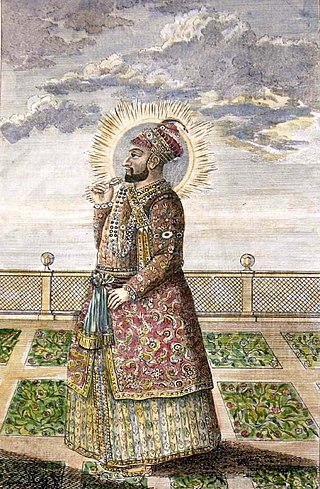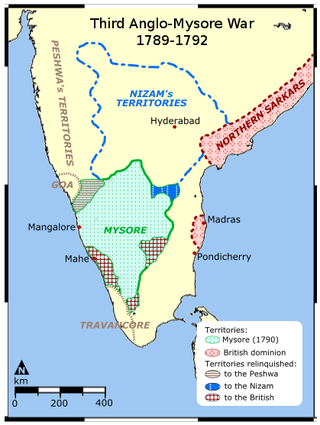
Tipu Sultan, commonly referred to as Sher-e-Mysore or "Tiger of Mysore", was the Indian Muslim ruler of the Kingdom of Mysore based in South India. He was a pioneer of rocket artillery. He expanded the iron-cased Mysorean rockets and commissioned the military manual Fathul Mujahidin. He deployed the rockets against advances of British forces and their allies during the Anglo-Mysore Wars, including the Battle of Pollilur and Siege of Srirangapatna.

Hyder Ali was the Sultan and de facto ruler of the Kingdom of Mysore in southern India. Born as Hyder Ali, he distinguished himself as a soldier, eventually drawing the attention of Mysore's rulers. Rising to the post of Dalavayi (commander-in-chief) to Krishnaraja Wodeyar II, he came to dominate the titular monarch and the Mysore government. He became the de facto ruler of Mysore as Sarvadhikari by 1761. During intermittent conflicts against the East India Company during the First and Second Anglo–Mysore Wars, Hyder Ali was the military leader.

The Maratha Confederacy, also referred to as the Maratha Empire or the Maratha Kingdom, was an early modern polity in the Indian subcontinent comprising the realms of the Peshwa and four major independent Maratha states who were often subordinate to the former. It was formed in 1674 with the coronation of Shivaji of the House of Bhonsle as the Chhatrapati of the Marathas. The Maratha realm was recognised by Bahadur Shah I, the Shahenshah of Hindustan as a tributary state in 1707 after a prolonged rebellion. The Marathas continued to recognise the Shahenshah as their nominal suzerain similar to other contemporary Indian entities.

Madhavrao I was the son of Peshwa Balaji Bajirao and grandson of Peshwa Bajirao I who served as 9th Peshwa of the Maratha Confederacy. During his tenure, the Maratha Confederacy recovered from the losses they suffered during the Third Battle of Panipat, an event known as Maratha Resurrection.

The Second Anglo-Mysore War was a conflict between the Kingdom of Mysore and the British East India Company from 1780 to 1784. At the time, Mysore was a key French ally in India, and the conflict between Britain against the French and Dutch in the American Revolutionary War influenced Anglo-Mysorean hostilities in India. The great majority of soldiers on the company side were raised, trained, paid and commanded by the company, not the British government. However, the company's operations were also bolstered by Crown troops sent from Great Britain, and by troops from Hanover, which was also ruled by Great Britain's King George III.

The First Anglo-Mysore War (1767–1769) was a conflict in India between the Sultanate of Mysore and the East India Company. The war was instigated in part by the machinations of Asaf Jah II, the Nizam of Hyderabad, who sought to divert the company's resources from attempts to gain control over the Northern Circars.

The Anglo-Mysore Wars were a series of four wars fought during the last three decades of the 18th century between the Sultanate of Mysore on the one hand, and the British East India Company, Maratha Empire, Kingdom of Travancore, and the Kingdom of Hyderabad on the other. Hyder Ali and his succeeding son Tipu fought the wars on four fronts: with the British attacking from the west, south and east and the Nizam's forces attacking from the north. The fourth war resulted in the overthrow of the house of Hyder Ali and Tipu, and the dismantlement of Mysore to the benefit of the East India Company, which took control of much of the Indian subcontinent.

The Third Anglo-Mysore War (1790–1792) was a conflict in South India between the Kingdom of Mysore and the British East India Company, the Kingdom of Travancore, the Maratha Confederacy, and the Nizam of Hyderabad. It was the third of four Anglo-Mysore Wars.

Miraj Senior was one of two Maratha princely states during the British Raj: 'Miraj Junior' and Miraj Senior. The two states separated in 1820. It was under the southern division of the Bombay Presidency, forming part of the southern Mahratta Jagirs, and later the Deccan States Agency.

Rama Varma I often referred to as Dharma Raja, was the Maharajah of Travancore from 1758 until his death in 1798. He succeeded his uncle Marthanda Varma, who is credited with the title of "maker of modern Travancore". During his reign Dharma Raja not only retained all the territories his predecessor had gained but administered the kingdom with success. He was addressed as Dharma Raja on account of his strict adherence to Dharma Sastra, the Hindu principles of justice by providing asylum to thousands of Hindus and Christians fleeing Malabar during the Mysorean conquest of Malabar.

The political history of the region on the Deccan Plateau in west-central peninsular India that was later divided into Mysore state and Coorg province saw many changes after the fall of the Hindu Vijayanagara Empire in 1565. The rise of Sultan Haidar Ali in 1761 introduced a new period.
The captivity of Kodavas (Coorgis) at Seringapatam was the period of capture, deportation, and imprisonment of Kodava Takk speaking Coorgi Christians who rebelled against Tippu Sultan, the de facto ruler of the Kingdom of Mysore, they (60,000-70,000) were caught during a number of attempts to suppress their rebellion in the 1780s.
The captivity of Nairs at Seringapatam was imposed on the Nairs of Malabar by Tipu Sultan, the de facto ruler of the Kingdom of Mysore from 1786 to 1799. They were subjected to forcible conversions to Sunni Islam, the official religious sect sanctioned by the Ottoman Caliphate, whose approval and alliance was sought by Tippu Sultan. Those who refused conversions had to face many humiliations, hardships, torture, and even death. The Nairs were treated with extreme brutality due to their strong adherence to the Hindu faith and martial tradition. The captivity ended when Nair troops from Travancore defeated Tipu in the Third Anglo-Mysore War. It is estimated that out of the 30,000 Nairs put to captivity, only a few hundred returned to Malabar alive.

Dhondia Wagh was a military soldier and adventurer in 18th century India. He started his career in the service of Hyder Ali, the ruler of Mysore. During the Third Anglo-Mysore War, he deserted Ali's successor Tipu Sultan, and subsequently raided territories on the Maratha-Mysore border. After the Marathas forced him to retreat, he sought refuge from Tipu and converted to Islam, changing his name to Malik Jahan Khan. After Tipu's death in the Fourth Anglo-Mysore War, he raised a force comprising soldiers from the former Mysore Army, and took control of northern part of the Mysore Kingdom. He styled himself as Ubhaya-Lokadheeshwara. The British East India Company as well as the Maratha Peshwa sent armies to check his rising power. He was ultimately defeated and killed by a British force led by Arthur Wellesley.
The Maratha–Mysore wars were a conflict in the 18th century India between the Maratha Confederacy and the Kingdom of Mysore. Though initial hostilities between the sides started in 1760s, the last battle began in February 1785 and ended in 1787.

The Mysorean invasion of Malabar (1766–1792) was the military invasion of the Malabar region of Kerala, including the territories of the Zamorin of Calicut, by the then-de facto ruler of the Kingdom of Mysore, Hyder Ali. After the invasion, the Kingdom of Cochin to the south of Malabar became a tributary state of Mysore.

The Kingdom of Coorg was an independent kingdom that existed in India from the 16th century until 1834. It was ruled by a branch of the Ikkeri Nayaka. From 1780 to 1788, the kingdom was occupied by neighbouring Mysore but the Rajah of Coorg was restored by the British and became a protectorate of the British East India Company on 26 October 1790. In 1834, the then Raja of Coorg rebelled against British authority, sparking the Coorg War. The brief conflict led to the British to annex the kingdom in the same year, who transformed the region into a province of British India.
The Battle of Ooscota was a battle in the First British-Mysore War, a conflict between the British East India Company and Hyder Ali, the sultan of the Kingdom of Mysore. It took place on the night of the 22–23 August 1768.

The Battle of Rattihalli, fought in 1764, pitted the forces of the Maratha Confederacy against those of the Mysore forces led by Hyder Ali. The Maratha army was commanded by Peshwa Madhavrao.

The Battle of Moti Talab, which took place on March 5, 1771, was a significant engagement between the forces of Mysore, led by Hyder Ali(who was succeeded by his son Tipu Sultan after his death), and the Maratha army, commanded by Trimbak Rao. The battle resulted in a decisive victory for the Marathas















